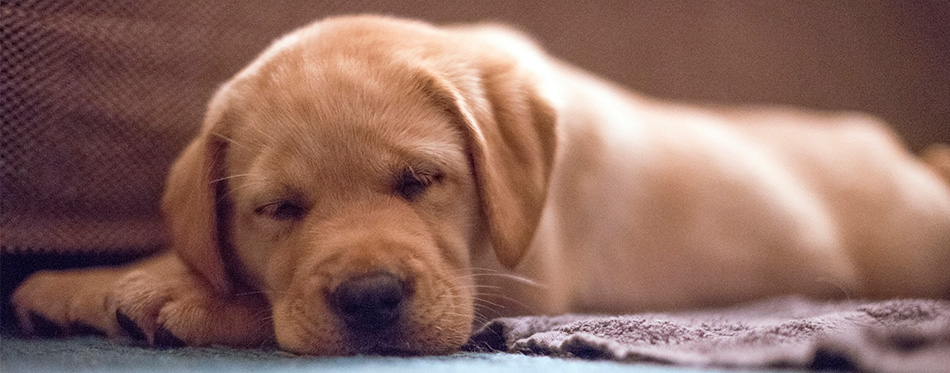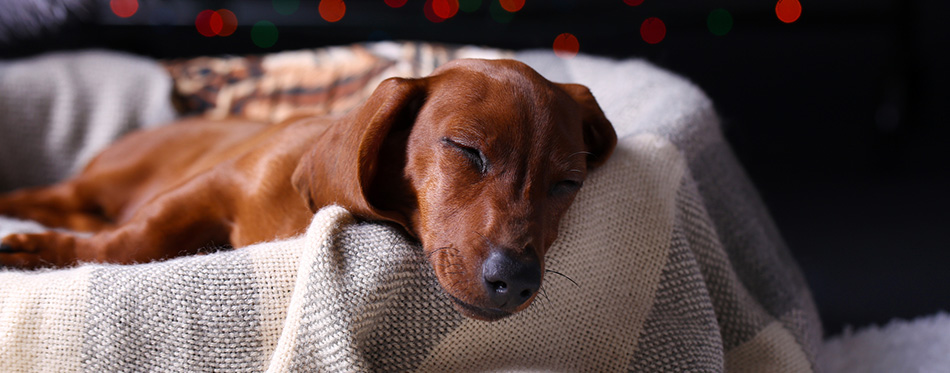There’s no doubt that you will have seen dogs fast asleep plenty of times, but sometimes, it seems like they are lost in a dream world. You can usually tell by the twitching of their eyes and their paws! But you may be wondering whether your pooch is actually dreaming, and if so, what about? While we can’t answer these questions with 100 percent certainty, studies have been conducted which can shed some light on the subject. So, let’s begin our investigation of doggy dreams.

What Do Dogs Look Like When Dreaming?
Most dogs don’t lie entirely still when they are sleeping. In fact, there are all sorts of actions associated with pooch sleep including the twitching of their paws, movement of their legs, and even sounds like whimpering. While the major muscles in your dog’s body are paralyzed, the smaller ones are not. Dogs move a lot more during their sleeping hours than a lot of other species. If you have not owned a dog before this can seem a little startling at first, but you soon become used to it. If you are worried about your dog, you should know that a seizure looks very different, and will involve bigger and more dramatic movements. Some dogs do suffer from REM behavior disorder, which is very similar to sleepwalking. Take your dog into the vet if you suspect they have a sleep disorder.
Take a look at our reviews of Dog Beds and Indestructible Dog Beds for more options.
Do Dogs Dream?
While we cannot be entirely sure, scientists believe that most vertebrates dream – even the tiniest ones. Of course, we cannot as them directly, but the sleep cycle of dogs have been observed closely, and many links can be made to our own. For example, there are times when your dog is wakeful, which is followed by the rapid eye movement (REM) sleep. In human beings, this is when our most vivid and memorable dreams occur, and this is the time when scientists believe our bodies are processing memories – amongst other things.
One of the most famous experiments involving animals and sleep was conducted using lab rats. Their brain waves were recorded while they were running through a maze, and then again while they were asleep. The lead scientist Wilson recorded that the rats’ brains were firing the same neuron patterns, and they could even work out which maze the animals were dreaming themselves in! While there haven’t yet been similar experiments conducted on dogs, from what has been observed, it seems highly likely that dogs are dreaming too. After all, they are asleep for around half their lives, so it appears to make sense that something is going on!

What Do Dogs Dream About?
Again, this is a subject that we can only speculate about as we have yet to find an accurate way to communicate with dogs or record their dream activities. However, the experiment on rats mentioned above suggests that they dream about their day to day activities. Another experiment was conducted on cats where scientists prevented them from being paralyzed during sleep. When they entered the REM cycle, they got up and moved as if they were following an object. Some even pounced on invisible objects, suggesting that they were dreaming about hunting.
If we expand what has been learned about mice and cats to what do dogs dream about, it seems that the dreams of animals are similar to their lifetime experiences. It could be that they are playing a game of fetch with you, going out on a walk, or simply showing you some love and affection. We have all observed dogs when all their paws start twitching and it seems as if they are running. This could be during the particularly active parts of their dreams.
Based on what we know about our own dreams, memory and experience play a crucial role in forming their content – and it is likely that the same is true in what do dogs dream of. Of course, these may not be exact replays of what has happened during the day (we all know how strange our own dreams can be) but they are broken up and put together in different ways. And they could have the same job as in humans of processing memories and helping them to make sense of their past experiences.
Related Posts: Orthopedic Dog Beds and Heated Dog Beds
Do Dog Dreams Vary?
There is some indication that the breed of your dog can affect the way in which they dream. For example, it seems that smaller dogs have more frequent dreams than larger ones. But the bigger dogs seem to dream for a longer period of time. We can also make an educated guess that what your dog does during the day is going to influence their dreams. For example, pooches who are frequently bounding around outside are much more likely to have more active dreams than those who prefer simply lounging around the house.
Should I Wake My Sleeping Dog?
You probably know the feeling of being woken up when you were in a very deep sleep – and it is not a particularly pleasant one. So, when you notice that your dog is in REM sleep, it is best to leave them alone. While it may not be the interruption of the dream that is the problem, your dog may become startled or confused by their surroundings – and this may make them behave in a way that is not normal. We know that not all of our dreams are good ones, so we can also make the assumption that dogs have nightmares too. If you wake a dog when they are having a nightmare, they may perceive you as the threat in their confused state, which can be dangerous – especially if you have young children around. It is best that you let your dog finish their dream, and then comfort them later if you think that they need it.

Final Thoughts
While we cannot conclusively answer the question do dogs dream, it seems very likely that dogs do dream and the subject is the things going on in their day to day life.
Source:
- Do Dogs Dream? – PetMD

